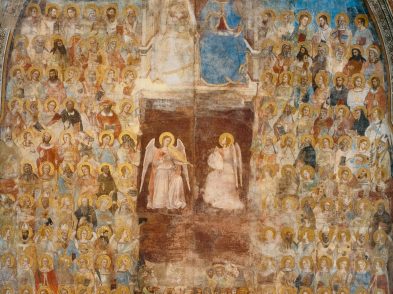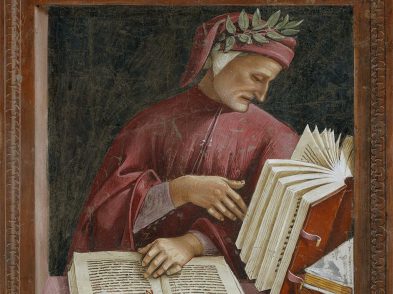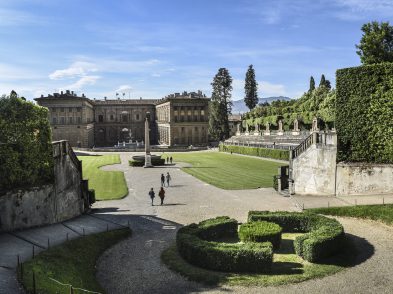What do a 33,600 euro bottle of wine and a restored bronze pharisee have in common? The answer is Friends of Florence. When Friends member Michael Corliss paid an astronomical sum for a nine-liter bottle of Ornellaia at a Christie’s auction in November 2007, he knew his money was going to a good cause: restoring the graceful group of three statues by Giovan Francesco Rustici in the architrave of the north door of the Baptistery of Florence.
Early in 2006, the U.S. based nonprofit organization Friends of Florence had pledged to restore Rustici’s Sermon of Saint John the Baptist, a bronze trio completed between 1506 and 1511 depicting John the Baptist with the pharisee and the levite. The statues belong to the Opera di Santa Maria del Fiore (the Duomo) and historical documents tell us that the group was commissioned to replace the Late Gothic figures by Tino da Camaino, judged ‘inadequate’ for the flourishing Renaissance city.
The decision to assign the Friends of Florence with the funding for the restoration was an important one, especially since the Opera del Duomo is constantly approached with offers for financing by large commercial organizations often looking to cover the monuments in publicity in exchange for their contribution. While such offers are certainly appreciated, the Opera has to be attentive to preserving the religious, artistic and cultural nature of its works. When current president of the Opera, Anna Mitrano, was approached by Friends of Florence she immediately felt comfortable accepting their generous gift. ‘Friends of Florence has proven itself as a serious and competent organization and we were only too happy to begin working with this group who had believed in and wanted this project for so long.’
By the time work began in the spring of 2006, the bronzes had undergone various cleanings throughout the centuries, necessary after being exposed in one of Florence’s busiest squares. Unlike many other precious bronze and marble statues in the city, the Rustici statues had never been removed for placement in a museum-even when they were cleaned, the statues remained in the architrave. In fact, the only time they were taken down for an extended period of time was during World War II, when they were kept in a warehouse near the train station along with most of Florence’s other precious artworks, stored for safekeeping during wartime bombing.
Restoration was entrusted to two experts and their teams, Ludovica Nicolai and Nicola Salvioli under the supervision of Annamaria Giusti for the Opificio delle Pietre Dure. The Opera del Duomo provided the workshop and the teams got down to business. After a preliminary study done on samples from various parts of the statues, the cleaning process began. Using low-pressure tools and deionized water, the restorers carefully and methodically removed the layers of dust, grime and wax that had accumulated over the years. They were rewarded for their efforts early on when the cleaning led to the discovery of gold leaf on the edges of the garments and sandals of all three statues and the buttons of the levite. A laser was used to delicately remove the dust from the gold leaf. The statues were then treated with a solvent, the bronze treated with wax and the gold leaf with an acrylic resin.
According to restorer Ludovica Nicolai, one of the most interesting discoveries was found inside one of the statues. ‘At one point while studying the interiors, we came upon a clod of dirt that had obviously been there from the beginning. The incredible thing about it was its shape: it was as if someone had taken a bit of dirt and squeezed it in their hand, it still had the indentations and everything. That definitely got our imaginations working overtime!’
Nicolai, the same restorer who completed the most recent work on both Verocchio’s and Donatello’s David, discussed the connection she felt to one of the statues in particular. Something about the pharisee’s intense gaze drew her in immediately.
However, it is the levite that is getting special attention these days, especially among Leonardo aficionados. It seems that Rustici and Leonardo da Vinci, both former apprentices in Verocchio’s workshop, lived together in a Martelli family palazzo during the time of Rustici’s John the Baptist commission. (A plaque outside the palazzo on via Martelli commemorates this fact). Even a quick look at the levite’s face-described by Giorgio Vasari as ‘a plump pumpkin which is most beautiful’-shows striking similarities to Leonardo’s well-known sketches and drawings.
Leonardo’s likely involvement piqued the interest of two important U.S. museums-the High in Atlanta and the Getty in Los Angeles-to request the bronze group on loan next year. Mitrano and the Opera agreed to loan the statues for a two-year period while the Museum of the Opera del Duomo is undergoing an extensive expansion project. ‘Loaning artwork is dicey-the last thing we want to do is deprive Florence of her precious works. However, we are pleased that the American public will have access to these exceptional pieces for a limited time while being studied by some of the world’s top Leonardo specialists’.
Before making the trip to the States, the restored statues can be seen inside the Baptistery where they were presented last December 19 in the presence of Archbishop of Florence Monsignor Giuseppe Betori, Superintendent of Florence’s Historic Patrimony Cristina Acidini and many other illustrious guests. As for the Friends of Florence members in town for the inauguration, one can’t help but wonder if they popped open the Ornellaia to celebrate the successful conclusion of yet another important Florentine restoration project.
For more information on this and other Friends of Florence projects, visit www.FriendsofFlorence.org.
The restoration was made possible by FRIENDS OF FLORENCE FOUNDATION with grants by the following donors:
Major grants for Saint John the Baptist
Ann O’Brien
Robert and Anne Krebs
Supporting grants for the levite
Leonard and Joy Dreimann
Friends of Heritage Preservation
Jeffrey and Nancy Moreland
Supporting grants for the pharisee
William and Julie Ballard
Michael Corliss
Marquises Ferdinando and Rosaria Frescobaldi
U.S. MUSEUM DATES
High Museum
Atlanta, Georgia October 3, 2009 to February 21, 2010
Part of the Leonardo da Vinci and the Art of Sculpture: Inspiration and Invention exhibition.
J. Paul Getty Museum
Los Angeles, California Dates TBA
A third museum has expressed interest in the statues; however, details were not available at press time. Check back with TF for updates.








